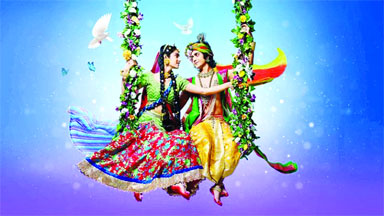
Ranga Panchami (also spelt as “Rang Panchami” or “Rang Panchmi”) is a significant festival for Hindus, predominantly celebrated in Uttar Pradesh, Madhya Pradesh, Maharashtra and other northern Indian regions. It falls on the Panchami tithi of Krishna Paksha in the month of Chaitra, five days after Holika dahan. However, in most years, the occasion is celebrated on Phalguna Krishna Paksha Panchami, which is the fifth day of the second fortnight of the Hindu month of Phalguna. This year, Ranga Panchami will be observed on 30 March.
PURANAS ASSOCIATED WITH RANGA PANCHAMI
Ranga Panchami is observed as a joyous occasion of love and vibrant colours, linked to the divine duo Radha-Krishna.
Another legend says that the occasion commemorates the rescue of Prahlada from a fire ignited by his aunt Holika, who was the sister of the demon king Hiranyakashipu.
FIRST LEGEND: RADHA-KRISHNA
Radha-Krishna represents the union of the Hindu deity Krishna with his primary consort and power, Radha. They are seen as the feminine and masculine aspects of God in various Krishnaite traditions within Vaishnavism.
In the Bhagavata sect or Krishnaism, Krishna is known as Svayam Bhagavan, while Radha is considered the original potency of God, embodying the three main potencies of Hladini (spiritual bliss), Sandhini (eternality), and Samvit (consciousness), with Radha specifically representing the feeling of love towards Krishna (Hladini).
Radha is revered as the Supreme Goddess alongside Krishna. It is believed that Krishna is only fully satisfied through loving devotional service, which Radha personifies. Many devotees worship Radha to reach Krishna through her. Radha is also seen as a manifestation of Krishna himself, divided into two for his pleasure. According to scriptures, Radha is considered the complete incarnation of Mahalakshmi.
While Krishna captivates the world, Radha captivates even him. Thus, she is considered the ultimate goddess, and together they are known as Radha-Krishna. In certain Vaishnava traditions, residents of Braj Bhoomi identify Radha and Krishna as the avatars of Lakshmi and Narayana.
SECOND LEGEND: HOLIKA
Prahlada, an asura ruler mentioned in Hindu texts, is renowned for his unwavering dedication to Vishnu, the preserver deity in Hinduism. He plays a significant role in the story of Narasimha, the lion incarnation of Vishnu, where he is saved from his wicked father, the asura king Hiranyakashipu, through a powerful act of disembowelment and death. Before that happened, Hiranyakashipu had employed Holika to kill Prahlada.
As per the Vishnu Purana, King Hiranyakashipu’s sister, Holika, tried to help her brother in his bid to eliminate Prahlada. Holika told her brother fire couldn’t burn her, thanks to a blessing she had received. Preparations were made for Prahlada to sit on his aunt’s lap, positioned on a blazing pyre. Nevertheless, as Prahlada fervently chanted the name of Vishnu, he emerged unharmed, while Holika met her demise in the flames.
In an alternative Purana, Hiranyakashipu instructs Holika to wear her scarf or fire-resistant garment to ensure his son’s death while keeping her safe on the pyre. Yet, when the flames blazed, the garment slipped off Holika and shielded Prahlada instead. Consequently, Holika perished in the fire, while Prahlada emerged unscathed.
RANGA PANCHAMI 2024: DATE AND TIME
The Panchami Tithi will commence on March 29, 2024, at 08:20 PM
The Panchami Tithi will conclude on March 30, 2024, at 09:13 PM
RANGA PANCHAMI SIGNIFICANCE
Ranga Panchami holds great importance in Hindu festivals, especially in the states of Uttar Pradesh, Maharashtra, Madhya Pradesh, and others in the north. It follows Holi celebrations and signifies the victory over tamasa and rajasa tattva, representing the pancha tattva (earth, air, space, water, and fire).
CELEBRATIONS
Devotees celebrate Ranga Panchami in temples dedicated to Krishna and Shiva, like the Banke Bihari temple in Vrindavan and the Mahakaleshwar temple in Ujjain. They offer prayers, play Holi with colours and flowers, dance, sing, and partake in various rituals to honour God on this day.
Ranga Panchami is predominantly celebrated in the northern regions of India. Devotees engage in playing with colours, offering prayers to Krishna and Shiva, and visiting temples associated with these deities to witness and partake in the vibrant festivities.
Many people believe that the Rang Panchami and Holi both are the same, but they are praised for a completely different purpose. Let us speak in various ways about the form of celebration.
Rang Panchami In Indore – A procession led by a water tank with a high-pressure jet, two ceremonial cannons and a camel circumambulation of the town is usually held during the Indore and Maharashtra festival. Everyone on the street is coloured.
Panchami Tithi is celebrated as traditional at Indore in Madhya Pradesh. Colourful processions in the city take place on this day. The colours give the whole city a distinct feeling. People are coming out of their homes with musical instruments. Readers should be aware that it is named “Ger.” This procession includes people from all faiths and castes. The colourful treat Indore seems to be looking forward to this day.
Rang Panchami In Maharashtra – After Holi’s celebrations end, the Maharashtrians participate in the Rang Panchami festivities, which are, of course, incomplete without colours. From Dhulandi onwards, the people from Maharashtra play Holi with great pleasure until they reach Panchami Tithi.
On Rang Panchami, gulal(colours) are widely used. Scrumptious delicacies continue to be Rang Panchami’s prime highlight, including Puran Poli as the most wanted item. The fishermen’s group is believed to be unique to this day.





Be the first to comment